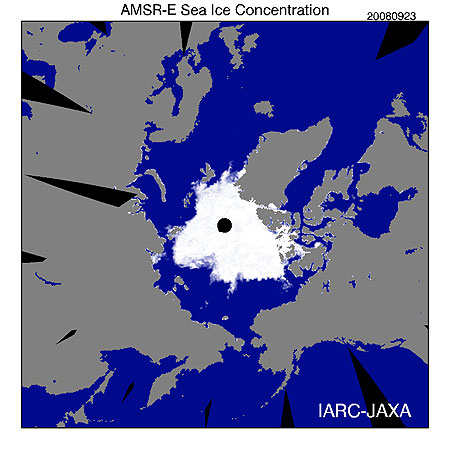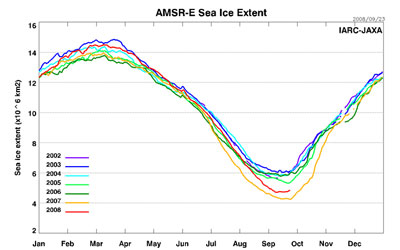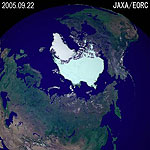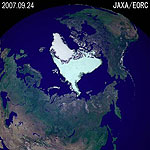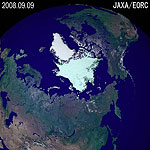Seen from Space 2008
Arctic sea-ice second smallest on record
Figure 1 presents the distribution of Arctic sea observed by AMSR-E on September 23, 2008, and Fig. 2 depicts the seasonal variation of the Arctic sea-ice concentration observed daily from 2002 with respective colored lines every year. The orange line (2007) indicates a rapid decrease from the beginning of July. The sea ice subsequently reached the lowest area since satellite measurements began. The red line (this year) suggests the same shrinking rate as in 2005 and 2006 up to the beginning of August, and still continuous rate up to September, although the melting rate was usually slow after mid August. As a result, annual minimum extent of sea-ice this year reached to an area slightly larger than that of the lowest record measured in 2007. An area of sea ice 1.6 times as great as the Japanese Archipelago was lost compared with the second previous record low measured in 2005. The sea-ice area shrank at a constant rate for two weeks beginning on September 9, but the area was expected to increase because the edge of the sea ice began to freeze after the autumnal equinox.
This year (2008) sea ice remained in the Siberian Sea after having disappeared in 2005 and 2007. Furthermore, the sea ice near Canada also disappeared, although the thick, old (multi-year) ice was usually dense. You can see that the edge of the sea ice retreated from Alaska to Canada and its area shrank. In addition, sea ice flowed into the Atlantic Ocean along the east bank of Greenland last year, but not this year. The article Arctic Sea Ice getting thinner and thinner of this ‘Seen from SpaceEseries noted that the Arctic sea ice was very thin and fragile this spring. This summer’s weather was not more suited for melting sea-ice than that of last year with respect to sunshine, although fine weather continued for a very long time last year. Instead, the second lowest sea-ice record is considered due to the rapid thinning of the spring sea-ice seen within a recent few years. Thus, the Arctic sea ice is likely to get easier to melt under usual air and sea-water temperatures in summer. JAXA has continued to monitor the Arctic sea ice and to report the latest information. You can find the latest data and images of sea-ice extent in the Arctic Ocean as well as previous observation images on Arctic Sea-Ice Monitor in the IARC-JAXA information system (IJIS) maintained by JAXA and located at the International Arctic Research Center (IARC, Fairbanks, Alaska).
|
||||||||||||||||||||||||||||||
